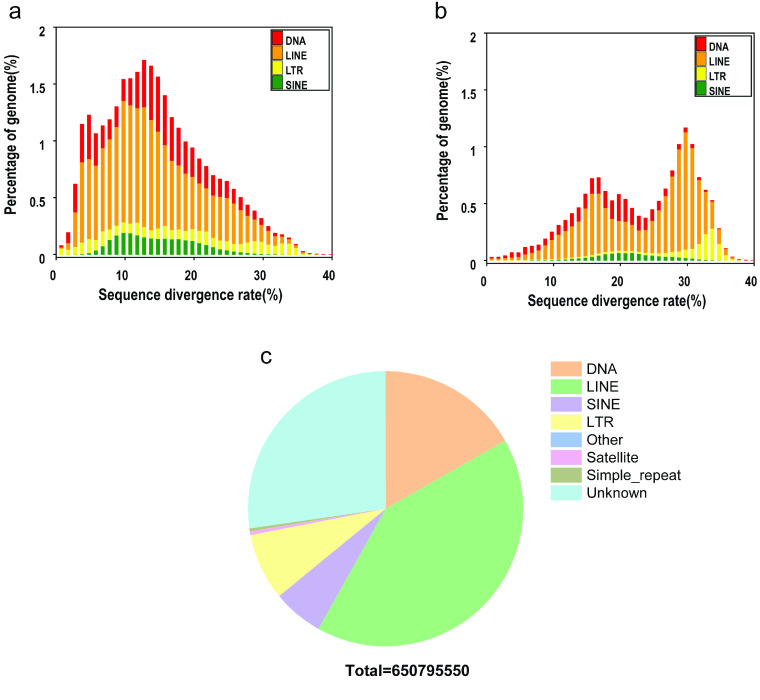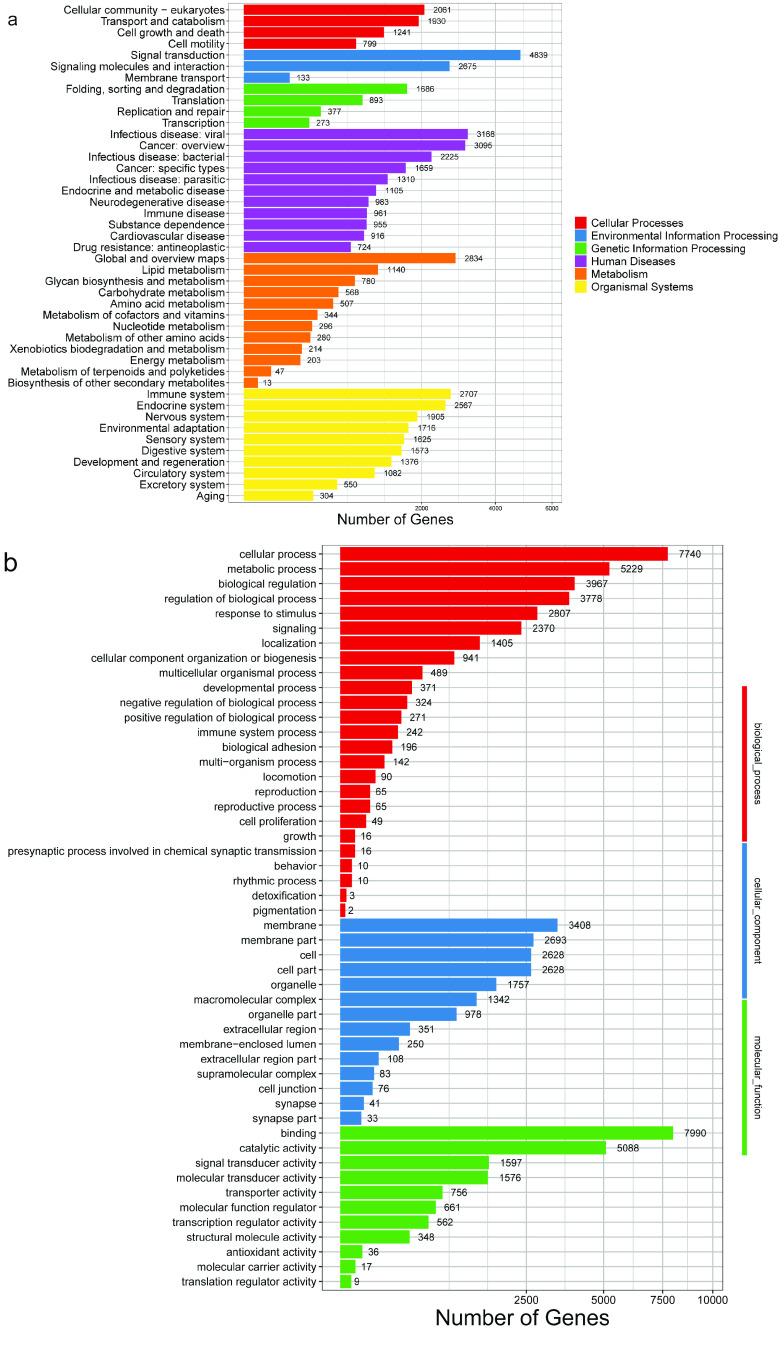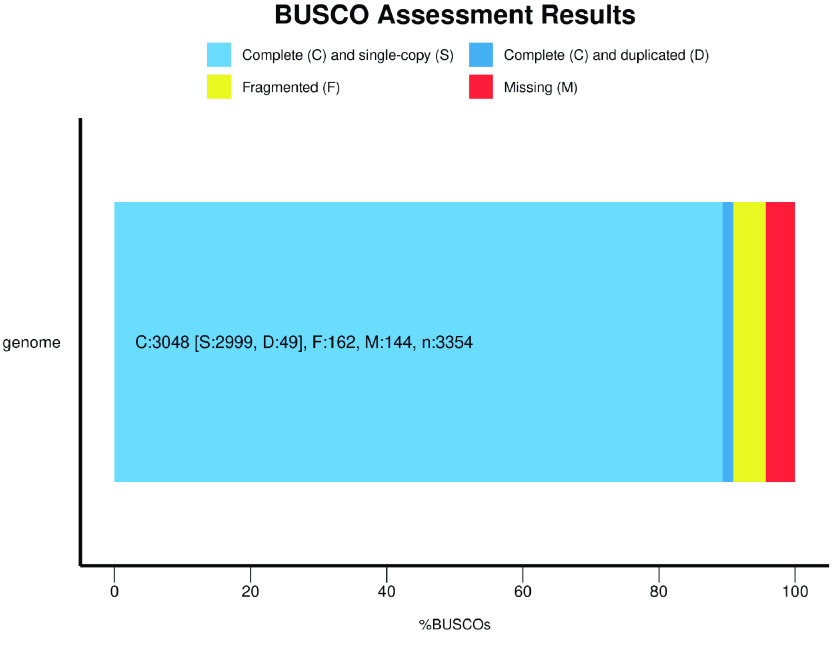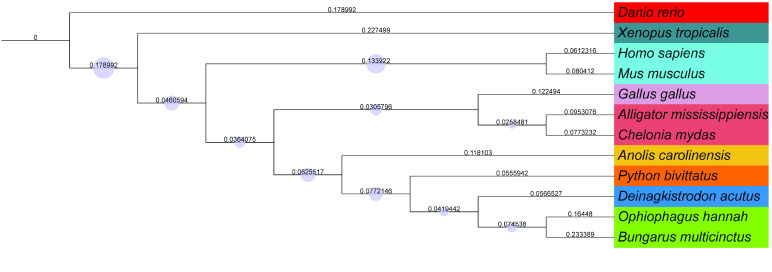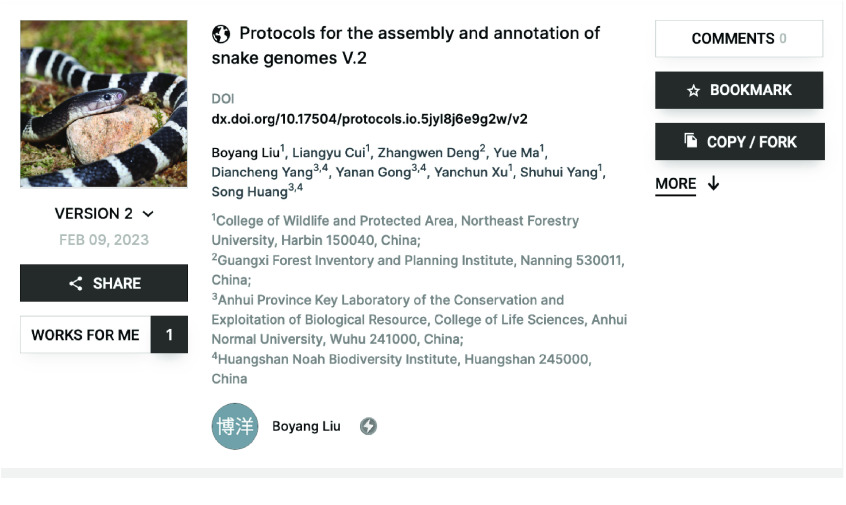Abstract
Snakes are a vital component of wildlife resources and are widely distributed across the globe. The many-banded krait Bungarus multicinctus is a highly venomous snake found across Southern Asia and central and southern China. Snakes are an ancient reptile group, and their genomes can provide important clues for understanding the evolutionary history of reptiles. Additionally, genomic resources play a crucial role in comprehending the evolution of all species. However, snake genomic resources are still scarce. Here, we present a highly contiguous genome of B. multicinctus with a size of 1.51 Gb. The genome contains a repeat content of 40.15%, with a total length exceeding 620 Mb. Additionally, we annotated a total of 24,869 functional genes. This research is of great significance for comprehending the evolution of B. multicinctus and provides genomic information on the genes involved in venom gland functions.
Introduction
Snakes are a fascinating group of reptiles that exhibit unique and diverse characteristics. With approximately 3,070 extant species in all continents except Antarctica [1], they are known for lacking limbs, elongated body shapes, and an exclusively carnivorous diet. Snakes have evolved many specialized adaptations, such as infrared sensing pits and a venom apparatus, which provide them with exceptional predatory capabilities [1]. These adaptations have made snakes important model organisms for evolutionary studies, yielding insights into limb development, sex chromosome evolution, and venom evolution. In recent years, genetic approaches have become increasingly important in understanding the evolution and diversity of snakes [2]. By exploring the evolution of venomous snakes, we can gain a deeper understanding of the ecological and evolutionary roles of these intriguing species.
Bungarus multicinctus (NCBI:txid8616), also known as the many-banded krait or umbrella snake, is widely distributed throughout southern Asia, its range spanning across countries such as India, Pakistan, Indonesia, Sri Lanka, Malaysia, Bangladesh, Vietnam, and China [3]. B. multicinctus is recognized as one of the ten most venomous snakes in China, with a lethality rate ranging from 26.9% to 33.3% [4].
In this study, we collected a muscle sample of B. multicinctus to generate a highly contiguous genome with a genome size of 1.51 Gb. Its repeat element content reached 41.68%, providing new evidence for understanding the relationship between repeat elements and genome size in Elapidae species.
Main content
Context
This study presents a highly continuous genome assembly of B. multicinctus. The genome size of B. multicinctus was found to be 1.51 Gb, with a GC content of 37.8% (Table 1). The maximal scaffold length was 39.68 Mb, and the N50 length was 6.55 Mb, indicating a highly continuous genome sequence. This draft genome sequence of B. multicinctus will serve as an invaluable resource for further research on venomous snakes, enabling a better understanding of their genetic makeup.
Table 1.
Summary of the features of our B. multicinctus genome.
| Contig | Scaffold | |
|---|---|---|
| Maximal length (bp) | 468,983 | 41,606,426 |
| N90 (bp) | 5,806 | 30,083 |
| N50 (bp) | 33,081 | 6,870,761 |
| Number ≥ 100bp | 163,090 | 82,383 |
| Number ≥ 2kb | 81,775 | 22,350 |
| Ratio of Ns | 0.045 | 0.045 |
| GC content (%) | 39.6 | 37.8 |
| Genome size (bp) | 1,548,488,562 | 1,621,955,402 |
The content of repetitive elements in our B. multicinctus genome was surprisingly large, reaching 41.68% with a total length of 675 Mb (Table 2). We analyzed the content of various repeating elements. While unknown types accounted for 51% of the repeating elements, LINEs and DNA transposons accounted for 10% and 8%, respectively (Figure 1). Research indicates that although snake species have similar genome sizes, they exhibit significant differences in TE content, with low diversity in the types of TEs [5]. Specifically, species with a longer evolutionary history tend to have higher TE diversity [6]. Our results suggest that the significant expansion of repeating elements is an important manifestation of species differences.
Table 2.
Summary of TEs in our B. multicinctus genome.
| Repbase TEs | TE proteins | De novo | Combined TEs | |||||
|---|---|---|---|---|---|---|---|---|
| Type | Length (bp) | % in genome | Length (bp) | % in genome | Length (bp) | % in genome | Length (bp) | % in genome |
| DNA | 32,816,331 | 2.02 | 2,921,569 | 0.18 | 112,067,211 | 6.91 | 129,267,220 | 7.97 |
| LINE | 174,481,405 | 10.76 | 154,961,354 | 9.60 | 276,722,230 | 17.07 | 301,624,987 | 18.61 |
| SINE | 13,524,698 | 0.83 | 0 | 0 | 39,754,823 | 2.45 | 43,837,124 | 2.70 |
| LTR | 23,313,679 | 1.44 | 30,431,704 | 1.88 | 52,496,522 | 3.24 | 60,898,786 | 3.76 |
| Other | 16,171 | 0.01 | 243 | 0.01 | 0 | 0 | 16,414 | 0.01 |
| Unknown | 0 | 0 | 0 | 0 | 182,574,604 | 11.26 | 182,574,604 | 11.26 |
| Total | 234,804,260 | 14.49 | 188,249,038 | 11.61 | 645,464,460 | 39.82 | 675,577,436 | 41.68 |
Figure 1.
Distribution of transposable elements (TEs) in the B. multicinctus genome. The TEs include DNA transposons (DNA) and RNA transposons (i.e., DNAs, LINEs (Long Interspersed Nuclear Elements), LTRs (Long Terminal Repeats), and SINEs (Short interspersed nuclear elements)). (a) Distribution of the de novo sequence divergence rate. (b) Distribution of the known sequence divergence rate. (c) Proportion and distribution of repeating elements.
We identified 24,869 functional genes of B. multicinctus and annotated them with Kyoto Encyclopedia of Genes and Genomes (KEGG). The majority of these genes were found to be involved in pathways related to Environmental Information Processing and Metabolism. This suggests that signal transduction-related genes play an important role in B. multicinctus (Figure 2). In addition, B. multicinctus genes were enriched in twelve metabolic pathways. The most enriched one was Lipid metabolism, and the least enriched one was Biosynthesis of other secondary metabolites.
Figure 2.
Gene annotation information of B. multicinctus. (a) KEGG enrichment of B. multicinctus. (b) Gene Ontology (GO) enrichment of B. multicinctus.
Data validation and quality control
We conducted a BUSCO (v5.2.2) (RRID:SCR_015008) assessment on the assembly to evaluate its integrity [7]. The assembly captured 90.9% of complete BUSCOs in the vertebrata_odb10 dataset (Figure 3).
Figure 3.
BUSCO Assessment result of our B. multicinctus genome.
To construct a phylogenetic tree, we screened closely related species, including Anolis carolinensis, Chelonia mydas, Danio rerio, Deinagkistrodon acutus, Gallus gallus, Homo sapiens, Mus musculus, Ophiophagus hannah, Python bivittatus, Xenopus tropicalis, and Alligator mississippiensis. Our data is consistent with previous studies and can be used to construct a phylogenetic tree that clusters closely related species (Figure 4) [8].
Figure 4.
Phylogenetic tree reconstructed using nuclear genome single-copy genes.
Methods
Detailed stepwise protocols are gathered in a protocols.io collection (Figure 5) [9] and summarised here.
Figure 5.
Protocols.io protocol collection for snake genome assembly [9]. https://www.protocols.io/widgets/doi?uri=dx.doi.org/10.17504/protocols.io.5jyl8j6e9g2w/v2
Sample collection and sequencing
B. multicinctus specimens were collected from Beiliu Longgukeng, Guangxi, and immediately transferred to dry ice for quick freezing. The samples were then stored at −80 °C. High-molecular-weight DNA was isolated using the protocol described by Wang et al. [10], and an stLFR co-barcoding DNA library was constructed using the MGIEasy stLFR Library Prep Kit (MGI, China). The libraries were sequenced using a BGISEQ-500 sequencer (RRID:SCR_017979) [11]. In addition, genomic DNA was isolated using the AxyPrep genomic DNA kit (AxyPrep, USA) for whole-genome sequencing.
We extracted the total RNA using the TRlzol reagent (Invitrogen, USA) following the manufacturer’s protocol. RNA quality, purity, and quantity were assessed using the Qubit 3.0 fluorometer (Life Technologies, USA) and the Agilent 2100 Bioanalyzer System (Agilent, USA). The cDNA libraries were generated by reverse-transcribing RNA fragments of 200–400 bp. All experimental procedures were approved by the Institutional Animal Care and Use Committee of Northeast Forestry University.
Genome assembly, annotation and assessment
The stLFR sequencing data obtained from the many-banded krait were subjected to assembly using Supernova (v2.1.1, RRID:SCR_016756) [12]. To improve the quality of the assembly, GapCloser (v1.12-r6, RRID:SCR_015026) and redundans (v0.14a) [9] were utilized for gap filling and redundancy removal, respectively, by incorporating the whole genome sequencing data.
To identify known repeat elements in the genome of the many-banded krait, Tandem Repeats Finder [13], LTR_FINDER (RRID:SCR_015247) [11], and RepeatModeler (v2.0.1, RRID:SCR_015027) [14] were utilized. RepeatMasker (v3.3.0, RRID:SCR_012954) [15] and RepeatProteinMask v3.3.0 [16] were employed for repeat element annotation. Protein-coding genes were predicted using de novo, homology-based, and transcript-mapping approaches. The de novo gene prediction was performed using Augustus (v3.0.3, RRID:SCR_008417) [17]. RNA-seq data were filtered using Trimmomatic (v0.30, RRID:SCR_011848) [18], and transcripts were assembled based on clean RNA-seq data using Trinity (v2.13.2, RRID:SCR_013048) [19] for RNA-seq-based prediction. PASA v2.0.2 [20] was utilized to align transcripts against the many-banded krait genome to obtain gene structures. Our homology-based prediction was performed by mapping protein sequences of the UniProt database (release-2020_05) of Pseudonaja textilis, Crotalus tigris, Thamnophis elegans, and Notechis scutatus to the B. multicinctus genome using Blastall v2.2.26 [21]. Gene models were predicted by analyzing the alignment results using GeneWise (v2.4.1, RRID:SCR_015054) [22]. Finally, the MAKER pipeline (v3.01.03, RRID:SCR_005309) [23] was employed to generate the final gene set, which represented RNA-seq, homology, and de novo predicted genes.
To perform functional annotations, a BLAST search (RRID:SCR_004870) was conducted against several databases, including SwissProt [24], TrEMBL [24], and KEGG [25], with an E-value cut-off of 1e-5. Furthermore, InterProScan (v5.52-86.0, RRID:SCR_005829) [26] was used to predict motifs, domains, and GO terms.
The genome completeness was evaluated by analyzing sets of BUSCO v5.2.2 using genome mode and lineage data from vertebrata_odb10 [27], following the standard scientific methodology.
To reconstruct the phylogenetic tree, OrthoFinder (v2.3.7, RRID: SCR_017118) [28] was used to search for single-copy orthologs among the protein sequences of Anolis carolinensis (GCA_000090745.2), Chelonia mydas (GCA_015237465.2), Danio rerio (GCA_000002035.4), Deinagkistrodon acutus [29], Gallus gallus (GCA_016699485.1), Homo sapiens (GCA_000001405.29), Mus musculus (GCA_000001635.9), Ophiophagus hannah (GCA_000516915.1), Python bivittatus (GCA_000186305.2), Xenopus tropicalis (GCA_000004195.4), and Alligator mississippiensis (GCA_000281125.4). The number of orthogroups of all species was 7,788.
Reuse potential
Venomous animals have fascinated and influenced humans since ancient times, and the venom gland is a special evolutionary mechanism that snakes have developed to adapt to their ecological environment [30]. In recent years, ecosystems have changed due to climate variations, and toxic species threaten not only humans but also native species and livestock [31, 32]. Therefore, it is crucial to collect genomic resources of venomous snakes and explore the formation mechanism of venom glands and venom production.
Genome assemblies of reptiles, including snakes, have always been challenging to generate. However, Xu et al. recently published an article on the origin of neurotoxins in the Elapidae family based on a high-quality genome assembly of the many-banded krait [29]. Using third-generation sequencing and Hi-C, Xu et al. assembled the many-banded krait genome to the chromosome level, achieving a BUSCO score of 94.6% and a scaffold N50 of 149.80 Mbp. Our assembly resulted in a BUSCO score of only 90.9%. Although our assembly did not achieve the same level of genome continuity as Xu et al., we obtained a relatively complete genome of the many-banded krait using stLRF second-generation sequencing data. Being sampled from a different geographic location provides a genomic resource for future research exploring the evolution and origin of reptilian species, including snakes.
Our data can be combined with already published and new venomous snake genome data to reconstruct the evolutionary history of venomous snakes and other reptiles. Our genome data can also be used in venomics research to explore toxic gland genes and the mechanism of toxic gland production.
Funding Statement
This work was supported by the Fundamental Research Funds for the Central Universities (No. 2572020DY02) and the Guangdong Provincial Key Laboratory of Genome Read and Write (grant No. 2017B030301011). This work was also supported by China National GeneBank (CNGB).
Data Availability
The data that support the findings of this study have been deposited into CNGB Sequence Archive (CNSA) [33] of China National GeneBank DataBase (CNGBdb) [34] with accession number CNP0004003. The data are also hosted in NCBI with accession number PRJNA934116. Additional data is available in the GigaDB repository [35].
List of abbreviations
GO, Gene Ontology; KEGG, Kyoto Encyclopedia of Genes and Genomes; LINEs: Long Interspersed Nuclear Elements; LTRs: Long Terminal Repeats; SINEs: Short Interspersed Nuclear Elements; TE, transposable element.
Declarations
Consent for publication
All experimental procedures were approved by the Institutional Animal Care and Use Committee of Northeast Forestry University (2023048).
Competing Interests
The authors declare no conflict of financial interests.
Authors’ contribution
SH, SY, and YX designed and initiated the project. ZD, DY, and YG collected the samples. BL, LC, and YM performed the DNA extraction and data analysis. BL, LC, ZD and TL wrote the manuscript. All authors read and approved the final manuscript.
Funding
This work was supported by the Fundamental Research Funds for the Central Universities (No. 2572020DY02) and the Guangdong Provincial Key Laboratory of Genome Read and Write (grant No. 2017B030301011). This work was also supported by China National GeneBank (CNGB).
References
- 1.Wiens JJ, Hutter CR, Mulcahy DG et al. . Resolving the phylogeny of lizards and snakes (Squamata) with extensive sampling of genes and species. Biol. Lett., 2012; 8(6): 1043–1046. doi: 10.1098/rsbl.2012.0703. [DOI] [PMC free article] [PubMed] [Google Scholar]
- 2.Rao W-Q, Kalogeropoulos K, Allentoft ME et al. . The rise of genomics in snake venom research: recent advances and future perspectives. GigaScience, 2022; 11: giac024. doi: 10.1093/gigascience/giac024. [DOI] [PMC free article] [PubMed] [Google Scholar]
- 3.Liang Q, Huynh TM, Ng YZ et al. . In vitro neurotoxicity of Chinese Krait (Bungarus multicinctus) venom and neutralization by antivenoms. Toxins, 2021; 13(1): 49. doi: 10.3390/toxins13010049. [DOI] [PMC free article] [PubMed] [Google Scholar]
- 4.Tian Y, Liu Z, Ma L et al. . Forensic identification of a fatal snakebite from Bungarus multicinctus (Chinese krait) by pathological and toxicological findings: a case report. Forensic Sci. Med. Pathol., 2022; 18(4): 497–502. doi: 10.1007/s12024-022-00517-x. [DOI] [PubMed] [Google Scholar]
- 5.Castoe TA, de Koning APJ, Hall KT et al. . The Burmese python genome reveals the molecular basis for extreme adaptation in snakes. Proc. Natl. Acad. Sci. USA, 2013; 110(51): 20645–20650. doi: 10.1073/pnas.1314475110. [DOI] [PMC free article] [PubMed] [Google Scholar]
- 6.Sotero-Caio CG, Platt RN II, Suh A et al. . Evolution and diversity of transposable elements in vertebrate genomes. Genome Biol. Evol., 2017; 9(1): 161–177. doi: 10.1093/gbe/evw264. [DOI] [PMC free article] [PubMed] [Google Scholar]
- 7.Simão FA, Waterhouse RM, Ioannidis P et al. . BUSCO: assessing genome assembly and annotation completeness with single-copy orthologs. Bioinformatics, 2015; 31(19): 3210–3212. doi: 10.1093/bioinformatics/btv351. [DOI] [PubMed] [Google Scholar]
- 8.Vidal N, Hedges SB. . The molecular evolutionary tree of lizards, snakes, and amphisbaenians. C. R. Biol., 2009; 332(2): 129–139. doi: 10.1016/j.crvi.2008.07.010. [DOI] [PubMed] [Google Scholar]
- 9.Pryszcz LP, Gabaldón T. . Redundans: an assembly pipeline for highly heterozygous genomes. Nucleic Acids Res., 2016; 44(12): e113, doi: 10.1093/nar/gkw294. [DOI] [PMC free article] [PubMed] [Google Scholar]
- 10.Wang O, Chin R, Cheng X et al. . Efficient and unique cobarcoding of second-generation sequencing reads from long DNA molecules enabling cost-effective and accurate sequencing, haplotyping, and de novo assembly. Genome Res., 2019; 29(5): 798–808. doi: 10.1101/gr.245126.118. [DOI] [PMC free article] [PubMed] [Google Scholar]
- 11.Zhao X, Hao W. . LTR_FINDER: an efficient tool for the prediction of full-length LTR retrotransposons. Nucleic Acids Res., 2007; 35(suppl_2): W265–W268. doi: 10.1093/nar/gkm286. [DOI] [PMC free article] [PubMed] [Google Scholar]
- 12.Weisenfeld NI, Kumar V, Shah P et al. . Direct determination of diploid genome sequences. Genome Res., 2017; 27(5): 757–767. doi: 10.1101/gr.214874.116. [DOI] [PMC free article] [PubMed] [Google Scholar]
- 13.Benson G. . Tandem repeats finder: a program to analyze DNA sequences. Nucleic Acids Res., 27(2): 573–580. doi: 10.1093/nar/27.2.573. [DOI] [PMC free article] [PubMed] [Google Scholar]
- 14.Smit A, Hubley R, Green P. . RepeatModeler Open-1.0. 2008–2015; http://www.repeatmasker.org.
- 15.Tarailo-Graovac M, Chen N. . Using RepeatMasker to identify repetitive elements in genomic sequences. Curr. Protoc. Bioinform., 2009; 4.10.1–4.10.14. Chapter 4. doi: 10.1002/0471250953.bi0410s05. [DOI] [PubMed] [Google Scholar]
- 16.Tempel S. . Using and understanding RepeatMasker. In: Bigot Y. (ed.), Mobile Genetic Elements. Methods in Molecular Biology, vol. 859, Humana Press, 2012. doi: 10.1007/978-1-61779-603-6_2. [DOI] [PubMed] [Google Scholar]
- 17.Stanke M, Steinkamp R, Waack S et al. . AUGUSTUS: a web server for gene finding in eukaryotes. Nucleic Acids Res., 2004; 32(suppl_2): W309–W312. doi: 10.1093/nar/gkh379. [DOI] [PMC free article] [PubMed] [Google Scholar]
- 18.Bolger AM, Lohse M, Usadel B. . Trimmomatic: a flexible trimmer for Illumina sequence data. Bioinformatics, 2014; 30(15): 2114–2120. doi: 10.1093/bioinformatics/btu170. [DOI] [PMC free article] [PubMed] [Google Scholar]
- 19.Haas BJ, Papanicolaou A, Yassour M et al. . De novo transcript sequence reconstruction from RNA-seq using the Trinity platform for reference generation and analysis. Nat. Protoc., 2013; 8(8): 1494–1512. doi: 10.1038/nprot.2013.084. [DOI] [PMC free article] [PubMed] [Google Scholar]
- 20.Haas BJ, Salzberg SL, Zhu W et al. . Automated eukaryotic gene structure annotation using EVidenceModeler and the program to assemble spliced alignments. Genome Biol., 2008; 9(1): R7. doi: 10.1186/gb-2008-9-1-r7. [DOI] [PMC free article] [PubMed] [Google Scholar]
- 21.Mount DW. . Using the basic local alignment search tool (BLAST). CSH Protoc., 2007; pdb.top17. doi:10.1101/pdb.top17. [DOI] [PubMed] [Google Scholar]
- 22.Birney E, Clamp M, Durbin R. . GeneWise and Genomewise. Genome Res., 2004; 14(5): 988–995. doi: 10.1101/gr.1865504. [DOI] [PMC free article] [PubMed] [Google Scholar]
- 23.Campbell MS, Holt C, Moore B et al. . Genome annotation and curation using MAKER and MAKER-P. Curr. Protoc. Bioinform., 2014; 48(1): 4.11.1–4.11.39. doi: 10.1002/0471250953.bi0411s48. [DOI] [PMC free article] [PubMed] [Google Scholar]
- 24.Amos B, Rolf A. . The SWISS-PROT protein sequence database and its supplement TrEMBL in 2000. Nucleic Acids Res., 2000; 1: 45–48. doi: 10.1093/nar/28.1.45. [DOI] [PMC free article] [PubMed] [Google Scholar]
- 25.Pitk E. . KEGG database. Novartis Found. Symp., 2006; 247: 91–103. [PubMed] [Google Scholar]
- 26.Jones P, Binns D, Chang H-Y et al. . InterProScan 5: genome-scale protein function classification. Bioinformatics, 2014; 30(9): 1236–1240. doi: 10.1093/bioinformatics/btu031. [DOI] [PMC free article] [PubMed] [Google Scholar]
- 27.Wick RR, Holt KE. . Benchmarking of long-read assemblers for prokaryote whole genome sequencing. F1000Research, 2019; 8: 2138. doi: 10.12688/f1000research.21782.4. [DOI] [PMC free article] [PubMed] [Google Scholar]
- 28.Emms DM, Kelly S. . OrthoFinder: solving fundamental biases in whole genome comparisons dramatically improves orthogroup inference accuracy. Genome Biol., 2015; 16(1): 157. doi: 10.1186/s13059-015-0721-2. [DOI] [PMC free article] [PubMed] [Google Scholar]
- 29.Xu J, Guo S, Yin X et al. . Genomic, transcriptomic, and epigenomic analysis of a medicinal snake, Bungarus multicinctus, to provides insights into the origin of Elapidae neurotoxins. Acta Pharm. Sin. B, 2023; 13(5): 2234–2249. doi:10.1016/j.apsb.2022.11.015. [DOI] [PMC free article] [PubMed] [Google Scholar]
- 30.von Reumont BM, Anderluh G, Antunes A et al. . Modern venomics—Current insights, novel methods, and future perspectives in biological and applied animal venom research. GigaScience, 2022; 11: giac048. doi: 10.1093/gigascience/giac048. [DOI] [PMC free article] [PubMed] [Google Scholar]
- 31.Linardich C, Brookson CB, Green SJ. . Trait-based vulnerability reveals hotspots of potential impact for a global marine invader. Glob. Change Biol., 2021; 27(18): 4322–4338. doi: 10.1111/gcb.15732. [DOI] [PubMed] [Google Scholar]
- 32.Giallongo G, Douek J, Harbuzov Z et al. . Long-term changes in population genetic features of a rapidly expanding marine invader: implication for invasion success. Biol. Invasions, 2021; 23(8): 2541–2552. doi: 10.1007/s10530-021-02521-8. [DOI] [Google Scholar]
- 33.Guo X, Chen F, Gao F et al. . CNSA: a data repository for archiving omics data. Database, 2020; 2020: baaa055. doi: 10.1093/database/baaa055. [DOI] [PMC free article] [PubMed] [Google Scholar]
- 34.Feng ZC, Li JY, Fan Y et al. . CNGBdb: China National GeneBank DataBase. Yi Chuan (Hereditas), 2020; 42(8): 799–809. doi: 10.16288/j.yczz.20-080. [DOI] [PubMed] [Google Scholar]
- 35.Liu B, Cui L, Deng Z et al. . Supporting data from: “The genome assembly and annotation of the many-banded krait, Bungarus multicinctus”. GigaScience Database, 2023; 10.5524/102410. [DOI] [PMC free article] [PubMed] [Google Scholar]



